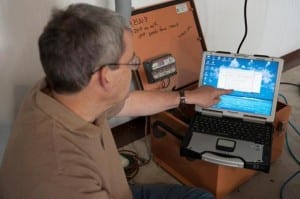Journalist Jehadu Abshiro of the SMU Daily Campus covered the research of SMU seismologist Heather R. DeShon.
DeShon is leading the effort to trace the source of a recent sequence of small earthquakes in North Texas and any relationship they may have to the injection of waste water by energy companies using shale gas production to recover gas.
North Texas earthquakes occurring in the Reno-Azle area since Nov. 5, 2013, and in Mineral Wells since Nov. 28, 2013, have raised scientific questions about the nature of these sequences and heightened local and national concerns about the impact of shale gas production on infrastructure and subsurface structures.
The Daily Campus article published Feb. 9, “SMU seismologists investigate cause of North Texas earthquakes.”
DeShon, an associate professor of geophysics, is an expert in earthquake generation within subduction zones and intraplate settings, seismogenic zone processes, local earthquake tomography and volcano seismology.
EXCERPT:
By Jehadu Abshiro
The Daily Campus
The Reno-Azle area, west of Fort Worth, has been experiencing more than 30 earthquakes since November, according to the U.S. Geological Survey.The largest earthquake was 3.7 on the Richter scale. The majority of the earthquakes are at a low magnitude.
“The real question is how big can these earthquakes get,” said Christopher Hayward, director of geophysics research at SMU.
A group of 12 SMU scientists and students, a well as a Lake Highlands High School intern, are currently studying the Reno-Azle area.
Associate geophysics professor Heather DeShon is leading the study and Hayward is leading the installation process. The group has installed 12 instruments so far.
Questions whether the earthquakes are occurring because of fracking by oil and gas companies lead a group of Azle, Texas residents to travel to the state capitol Jan. 23.
“It is important we do not rush to conclusions,” DeShon said at a press conference Friday. “I understand people want results quickly. But we have to sit and wait a little while.”
Fracking is the injection of water, sand and chemicals under high pressure into bedrock to increase the flow of oil or gas. Of the about 35,000 shale gas wells in the U.S., only two cases show fracking-induced seismicity.
According to Hayward, the wastewater injection wells are more of a concern. Wastewater injection wells, about 30,000 in the U.S., dispose of waste fluids from producing oil and gas wells by injection wells drilled below fresh water aquifers. According to Induced Seismicity Potential in Energy Technologies, there were eight case studies linking earthquakes to these wastewater wells in the U.S. in 2011.
Wastewater disposal is a separate process from the fracking operation and may occur away from the fracked well.



 Wall Street’s short sellers wrongly maligned — detected red flags ahead of US financial crisis
Wall Street’s short sellers wrongly maligned — detected red flags ahead of US financial crisis A director’s skills, experiences and workload drive their compensation, SMU study finds
A director’s skills, experiences and workload drive their compensation, SMU study finds Gut reaction of marital partners could foretell their marriage satisfaction
Gut reaction of marital partners could foretell their marriage satisfaction Fossil supervolcano discovered in Italy by SMU-led team is now key feature of new UNESCO Geopark
Fossil supervolcano discovered in Italy by SMU-led team is now key feature of new UNESCO Geopark NPR: “Boiling Hot: How Fracking’s Gusher of Geothermal Energy is Wasted”
NPR: “Boiling Hot: How Fracking’s Gusher of Geothermal Energy is Wasted” KERA, NOVA: SMU researcher Peter Weyand discusses the upper limits of human speed.
KERA, NOVA: SMU researcher Peter Weyand discusses the upper limits of human speed.
 The Undying Radio: Familiarity breeds content when it comes to listeners and music
The Undying Radio: Familiarity breeds content when it comes to listeners and music
